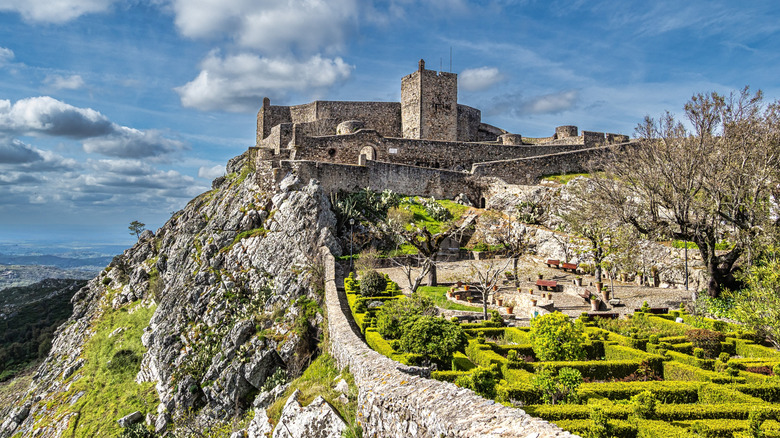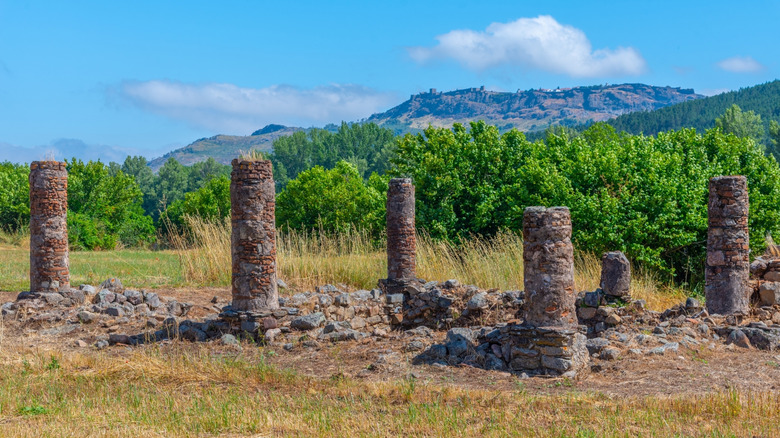Portugal's Secret Clifftop Medieval Village Preserves Whitewashed Buildings, Wine Tastings, And Lush Serenity
Without a doubt, Lisbon and Porto are stunning European travel destinations, but if you want to experience Portugal's quieter, more authentic side, venture out for a weekend or make a whole trip of exploring its smaller cities and villages. There are plenty of coastal gems to explore, including Salema, a beach town Rick Steves calls "untrampled by rowdy tourists." Still, inland Portugal is also rife with gorgeous destinations you shouldn't write off just because they're not by the ocean. Inland Portugal is much more varied in terms of elevation — you'll find medieval villages built on hilltops, like Marvão, which might just be your perfect trip into the historic, pastoral heartland of Portugal.
Marvão is sometimes referred to as an eagle's nest because of its perch nearly 3,000 feet high on a cliff in the rocky Alentejo region. It's a fortified village, so you'll notice the town is enclosed in preserved medieval walls that date back to the 13th century. Marvão's history dates back even further, and it includes ruins from the site of the ancient Roman city of Ammaia. Over thousands of years, Marvão passed from the hands of the Romans to the Islamic Empire to Christians. This confluence of forces has created a unique tapestry of architectural styles. Add on the fact that the whitewashed village is located within the lush Serra de São Mamede Nature Park, and you'll see why it's considered among the most beautiful towns in Portugal.
Explore Marvão's historical walls and castle
Likely the first thing you'll see in Marvão is its surrounding walls. Luckily, the walls won't bar you out today, but during the Middle Ages, they served an important role in defending the city from invaders. Starting in the 8th century, Marvão was under the rule of Moorish leader Ibn Marwan, for whom the town is named. Marwan kept the town intact as an outpost of the Islamic Empire until around the 12th century, when it was conquered by Christians and absorbed into the Portuguese kingdom.
For those flying in, Marvão is about a 2.5-hour drive east from the Lisbon International Airport. If you're coming from the north, it's just over a two-hour drive from Coimbra, the easy-to-enjoy city that's less crowded than Lisbon. Within its walls, you'll find white painted medieval buildings and churches all along cobbled streets, including charming places to stay overnight. One option is to stay at a pousada, a type of historic Portuguese inn.
Dominating over Marvão's nest, the Castle of Marvão can't be missed. Like the town walls, the castle was part of its defense system, with views out to the Spanish border to stay ahead of the neighboring country's army. Despite being over 1,000 years old, the castle has been well-preserved. The entrance fee is inexpensive, and you should climb up into the castle and wander its beautiful gardens at sunset, where sometimes you'll find vendors selling local products. You can even relax with a sandwich or glass of wine at the well-rated café near the castle, O Castelo.
See ancient Roman ruins and try regional wines in Marvão
Though the heart of Marvão lies within its city walls, it's worth venturing just beyond for two unmissable attractions: the Serra de São Mamede Nature Park and the ruins of Ammaia. The idyllic nature park extends all around Marvão, known for its humid mountain ecosystem with hiking trails. It's home to some rare birds of prey, including the park's emblem, the Bonelli eagle.
About a 12-minute drive from Marvão's center is the captivating archeological site of Ammaia. In the first century A.D., Ammaia was a thriving Roman powerhouse, with more residents than Marvão has today. Visitors can explore the open-air ruins, which include fragments of the forum, baths, and remaining pillars. At the on-site museum, you can see artifacts like coins and jewelry, or stroll through a preserved portion of an ancient Roman road.
Being in Alentejo, one of Portugal's most renowned wine regions, Marvão serves as a great base for sampling the region's best varietals. All around the hilltop city are sprawling vineyards, like the São Mamede Wine Project, just a seven-minute drive from Marvão's center. The São Mamede Wine Project notes that the high altitude of the region gives the wines their distinctive crisp, acidic character. You can try out the vineyard's wines at Salto Natural Wines, a bar about 20 minutes outside of Marvão. While in Portugal, you can also check out one of the world's oldest wine regions, the historic Douro Valley.


